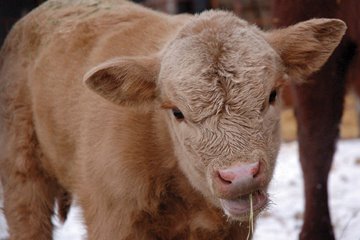
by Martin Unrau
Just like every fall, now is the time for all cow-calf producers to think about and make the toughest decision of the year - what do we do with our calves?
Do we retain ownership of our young calves by keeping and feeding them or putting them in a custom feedlot? Should we feed and finish our yearlings or do we simply sell everything off now?
The cow-calf guy isn’t the only one who has tough decisions to make. The feedlot owner is wondering whether grain prices will rise or fall and if he should buy cattle, or stick with custom feeding or do a little bit of both.
Last month it looked as though calf prices would be higher this fall than last, but with the financial difficulties in the U.S., the confidence level of both buyers and sellers in the cattle industry dropped, taking calf prices with it. Whether we like it or not, financial stability south of the border has a huge affect on the rest of the world. As I finish writing this article, the bailout bill in the U.S. has just passed but it is still too early to know how positively global economies will be affected and for how long.
The Canadian dollar sits at 92 cents. Last year in early October the dollar was at par and reached a modern-day high of $1.09 on November 7th. The modern-day low was 62.5 cents in April 2002. A big factor in the difference between calf prices now and six years ago is the value of the Canadian dollar.
So unless the market turns around, it looks like many of us are facing another year of scratching by with too little money for our calves.
For guys in the Interlake and Westlake areas, and those in the southwest, the challenge this fall is to find enough feed for the winter and the resources to pay for it. The decisions these cattlemen and women face are huge. I encourage everyone to be creative with the available feed and feed mixes and be sure to ask for advice. The MAFRI staff across the province are aware of the situation and are there to help.
The decision whether or not to buy in feed is a tough one - I know because that’s exactly what we had to do in 2003 because of drought. That purchase cost us, but the freight assistance program saved our hides (there was no program to buy feed back then either).
But I was 40 years old and my wife Roxie and I had made the decision we were staying in cows. I know from talking to guys older than myself that biting the bullet and taking on more debt when you’re 40 is an easier decision to make then when you are pushing 65.
So I guess the best advice I can give is that you have to take a look at where you are right now and make the decision that feels best for you.
There is no one right answer because every situation is different. Personally, I don’t want to see anyone who is passionate about staying in the cattle industry to be forced out. And I also don’t want to see anyone who has had enough, forced to stay in.
There are creative ways of getting around many problems, you just have to figure out what will work for you.
Start by taking a bit of a break. Try to relax your mind and say, “It is what it is. Now what do I do to fix or minimize the problem?”
Talk to positive people, the ones who always seem to figure their way out of a tough situation. Chances are they know how to think outside the box.
Take every negative you are experiencing and see if you can find a positive. For example, let’s say you don’t have enough feed for the winter but you want to stay in cows. Maybe selling off your oldest cows and buying back bred cows or heifers next year is the right option.
As disillusioned as I know many cattle producers are, I want to encourage everyone who has the will to stay in the business to take advantage of the financial options that are available.
And here at the MCPA we will continue to work on your behalf.
Because of the nature of what we do, we can’t always communicate with our membership, especially when in the middle of sensitive discussions. Often times when we are the quietest, the most progress is being made.
Remember to take time out to go to the district meeting in your area.
Hopefully I’ll see you there.


No comments:
Post a Comment